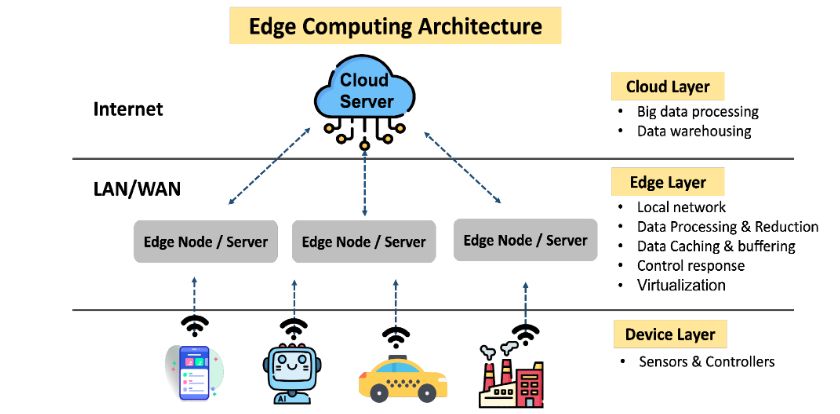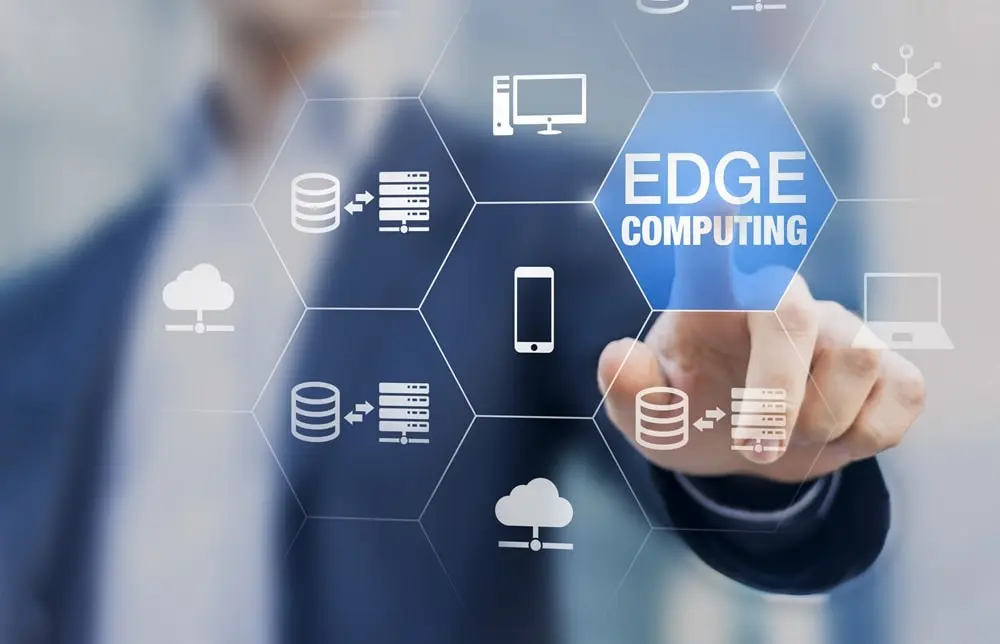Edge computing is basically a computing model that brings computation and data storage nearer to the sources of data. It is not a technology. It is an evolving entity.New technology is brought in to it all the time.it is a key to speeding up internet. It is actually an architecture consisting of interlinked devices.
Edge computing architecture has three layers:
- Cloud layer functions to process and store data.
- Edge layer function is to process data near real time.
- Device layer functions to detect and perform simple processing.

Working of Edge Computing:
Edge computing is all about the location. So, data is produced at the user endpoint, such as a user’s computer or laptop. This data is then transferred across a WAN such as internet through LAN. Here, the data is stored and processed by the enterprise location. The results of that work are then moved back to the client endpoint. For typical business applications, this is a proven approach to client-server computing.
As too many devices are connected to the internet and the number of these devices is increasing rapidly day by day. It results in an increase in data production. So, for the traditional data center infrastructures to accommodate this data, it is a great difficulty. It is where edge computing comes to the picture. Gartner predicted that by 2025, 75% of the data generated by enterprise.
Edge computing is not a new concept. It is rooted in the ideas of remote computing which is decades old. Such as in remote offices and branch offices, it was more reliable to place computing resources at the nearer or desired location instead of depending on a single central location.
Edge computing puts storage and the servers basically where the data is. It often requires a partial rack of gear to operate on the remote LAN to collect and then process data locally. Processing involves often analyzing and processing the data stream to look for the business intelligence and results of the analysis are transferred back to the principal data center. The idea of business intelligence varies. Examples include predictive analytics that guide maintenance of equipment and repair before an upcoming failure or disaster.
Real life applications of Edge Computing:
Below are some of the applications of edge computing:
1. Traffic management:
Edge computings assists very effective city traffic management. Its examples include optimising frequency of bus given fluctions in demand. It also involves managing and clsing of extra lanes. Due to edge computing, the traffic date is no longer transported to the centralised cloud. It reduces the cost of latency and brandwidth.
2. Remote monitoring of assets in oil and gas:
Oil and gas failures are very harmful and have drastic effects. Therefore, these assets should be monitored with great care.however, oil and gas plants are often in remote locations.it enables real time analytics with processing much closer to the asset. Therefore, a good quality connection to a centralised cloud is no longer relied. Edge computing has made easy to monitor these large industries.
3. Smart speakers:
They can gain the ability to interpret voice instructions to perform the basic task assigned. Even if the internet connection falls down, turning on and off lights and adjusting thermostat settings would be possible.
4. Video conferencing:
Poor vedio quality and paused screen…..a slow link to cloud cause many vedio conferencings frustrations. So, if the server side of vedio conferencing software is placed near the participitant, quality of the vedio is much improved.
5. Advertising:
The information and targeted ads for retail organizations are based on the key moments such as demographic information, set on field devices. In this case, edge computing helps to protect user privacy. It encrypts the data and keeps the source and doesnot send unprotected information to the cloud.
6. Autonomous vehicles:
The decision to stop for a pedestrian crossing in front of an autonomous vehicle (AV) must be made very quickly.it is not reasonable to rely on a remote server to handle such a decision.vehicles that use edge computing communicate with each other more efficiently in the case of accidents, traffic jam, unfavourable weather conditions. So, edge computing helps in this regard.
7. Retailed advertisisng:
The information and targeted ads for retail organizations are based on the key moments such as demographic information, set on field devices. In this case, edge computing helps to protect user privacy.it encrypts the data and keeps the source and doesnot send unprotected information to the cloud.
8. Predictive maintainence:
Edge computing helps the manufacturers to dectect and analyse failures in their production lines before the failure occures.it helps them to save from any big disaster afterwards.it does this by bringing the processing and storage of data nearer to the the equipment. It enables IOT servers monitor the health of machine with low latencies and and perform the required analytics.
9. Virtualised vedio networks and 5G (vRAN) :
The objective of operators now is to virtualise the parts of their mobile networks (vRAN).It has cost benefits along with the flexibilty benefits.The new virtualised RAN hardware do complex processing with very less latency. Operators therefore need edge severs to support virtualising their RAN more near to the cell tower.
10. Cloud gaming:
It is a new kind of gaming in which live feed of the gameis directly streamed to the devices. In data centers, game is processed and hosted. Cloud gaming companies aim to build edge servers as close to the gamers as possible in order to reduce latency and provide a fully responsive and immersive gaming experience.
11. Smart homes:
Smart homes depend upon IoT devices for the collection and process of data from the house. To a centralized remote server, often this data is sent, where it is processed and is stored. However, this architecture has drawbacks and backhaul cost, latency, and security. By using edge computing and bringing the processing and storage closer to the smart houses, the problem of backhaul and round-trip time is solved to a great extent and sensitive information can be processed. As for example, for vice based assistant devices such as Amazon’s Alexa, the time taken to respond would be much quicker than before.
12. Health care monitoring:
Edge computing plays a huge role in the healthcare industry. In the tools like ultrasound scanning and different time sensitive tools, response time must be shorter. Edge computing devices reduce
13. Robotics:
We can take advantage of edge computing to assist surgeries. Implementation of edge computing on robotic assisted surgeries provides regular updates which then help to take the crucial steps regarding operations and patient’s health.
14. Content delivery:
At the edge, by catching the content like music, videos, web pages, improvements to deliver content can be made. latency can also be reduced. Content providers are aiming to distribute CDN’s even more widely to the edge, thus guarantee flexibility and customization on network depending on the user traffic demands.
Difference between cloud computing and edge computing:
| Cloud computing | Edge computing |
|---|---|
| Centralized servers are stored in far away, large scale data centers. | In this the infrastructure of global computing is located closer to the users and devices. |
| Data is processed on the cloud server which is located far from the data sources. | Data is processed and analyzed quickly in real time on the sites. Storage of data is not focused in edge computing. |
| It is more efficient for the applications which are not time sensitive. | It is suited more for the time sensitive devices which require low latency for better efficiency because every millisecond counts. |
| For long term analysis and in-depth verification, it is more suitable. | For fast and real time analysis, it is more ideal. |
| Internet connectivity is required. | It does not need internet connectivity. |
| It is used for expensive and intensive operational activity for the company. | It ensures automated scalability with zero-touch provisioning. |
| The connectivity, data movement and bandwidth are relatively high. | Latency is relatively low. Performance has increased due to bandwidth requirements. |
| Operations costs involving cloud computing are relatively high. | Operations performed have lower expenses. |
IT Challenges tackled by Edge Solutions:
Gartner says that 5.8 billion IoT devices will be in action this year. IoT devices are increasing by more than 20% each year. It makes sense too. Currently, data flow is mostly through the cloud to the remote data storage facility. But a less distributed approach is demanded for the proliferation of devices. It is true and more IoT applications are sold out to function in real-time. Customers act as if the “I” in the IoT stands for “immediate”, a delay in response will upset and frustrate the customers and eventually will impact the corporate bottom-line results.
A good alternative to cloud computing is edge computing. Instead of processing and analyzing data through a remote data center, processing IoT data at the edge of the network removes the challenges faced today by centralized IT environment. Placing data centers closer to the devices where the information is processed locally in a very short time and the rest of the data goes through the cloud solves some big challenges, such as:
Latency issues:
Latency issues slow down networks. Edge computing eliminates the lag-time between real-time devices and delivers the command of the customer immediately. This creates an interface between the device and the customer which is much more reliable. New IT tools like Alexa and autonomous cars are greatly impacted by edge computing as they need to produce the response in split seconds.
Security issues:
Edge frameworks make sure to restrict the data outrages to the local processing center and applications which are run by that device. It includes technologies and hardware that allow data analyzation without exposing all the details. Examples include secure enclaves, federated learning, homomorphic compute.
Cost issues:
The cost can decrease significantly on edge, reducing operating expenses and capital. You can plan for failure of equipment and replacement, making this a budgetary line item.
Hurdles in IT centralization:
Real time data is streamlined without the hurdles in IT centralization. Edge computing is entirely focused on specific increments of data, with reduced lag time.
Challenges faced by edge computing:
Below are the highlighted risks:
Reliability: sometimes, the computing edge devices are not very reliable and the user faces issues.
Security: Data processing and analyzing is performed outside the network edge, which results in the leak of personal information. Security issues arise and customers don’t trust the system.
Compatibility: some IT devices produce too much data and for edge computing to handle this vast amount of data, it is difficult.
Contracts and lock-in: Contracts and lock-in are required to use this system, there is need to sign the contracts.
Edge Computing as a problem solver in future:
Computing edge will surely be a problem solver soon. It informs us to make decisions in the meantime. It makes sure the quick response. As all the data cannot be handled by a single cloud server. Edge computing devices near the user manage the data processing and analyzing. In the devices, which are time sensitive and need quick response to make decisions, edge computing is bliss.


